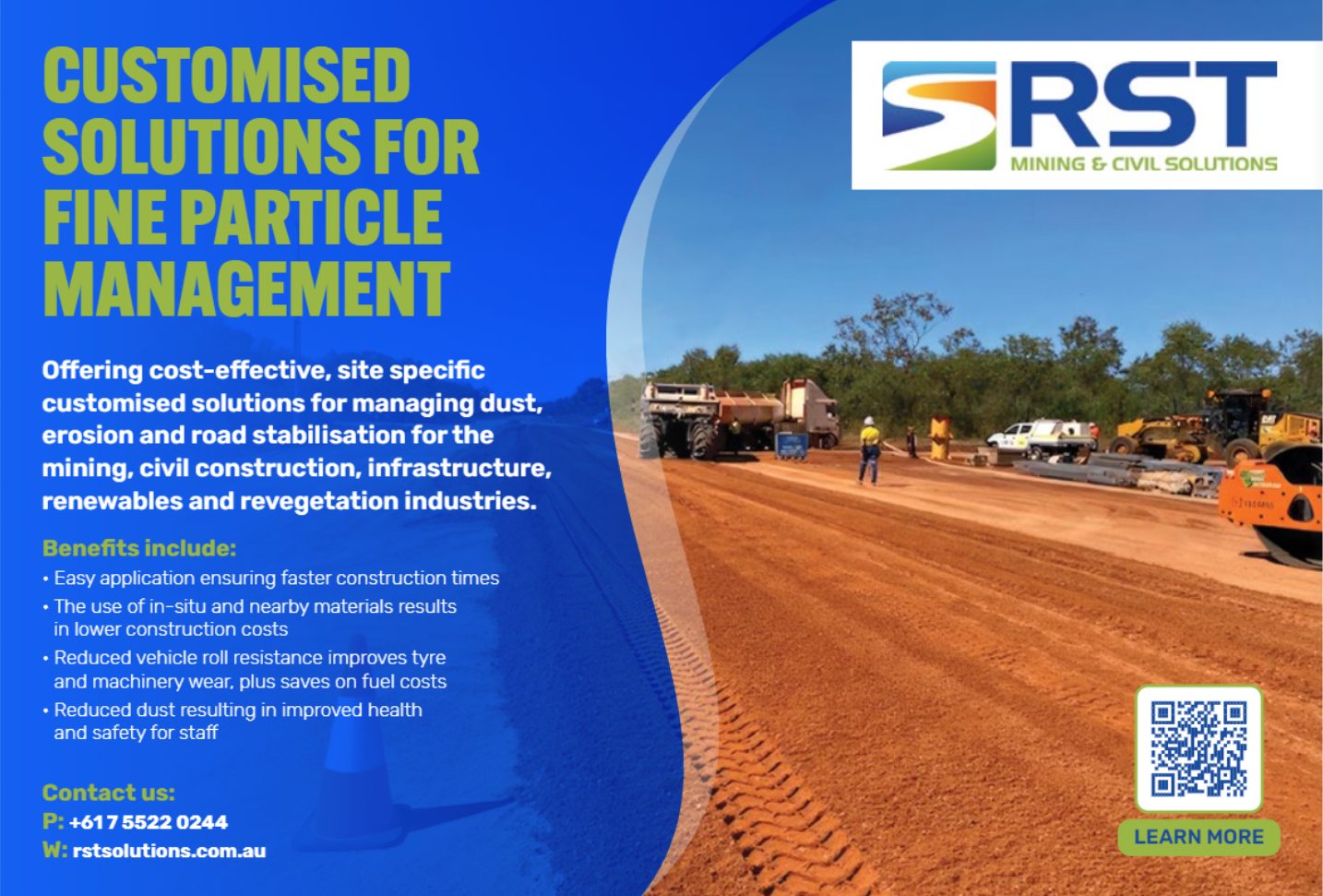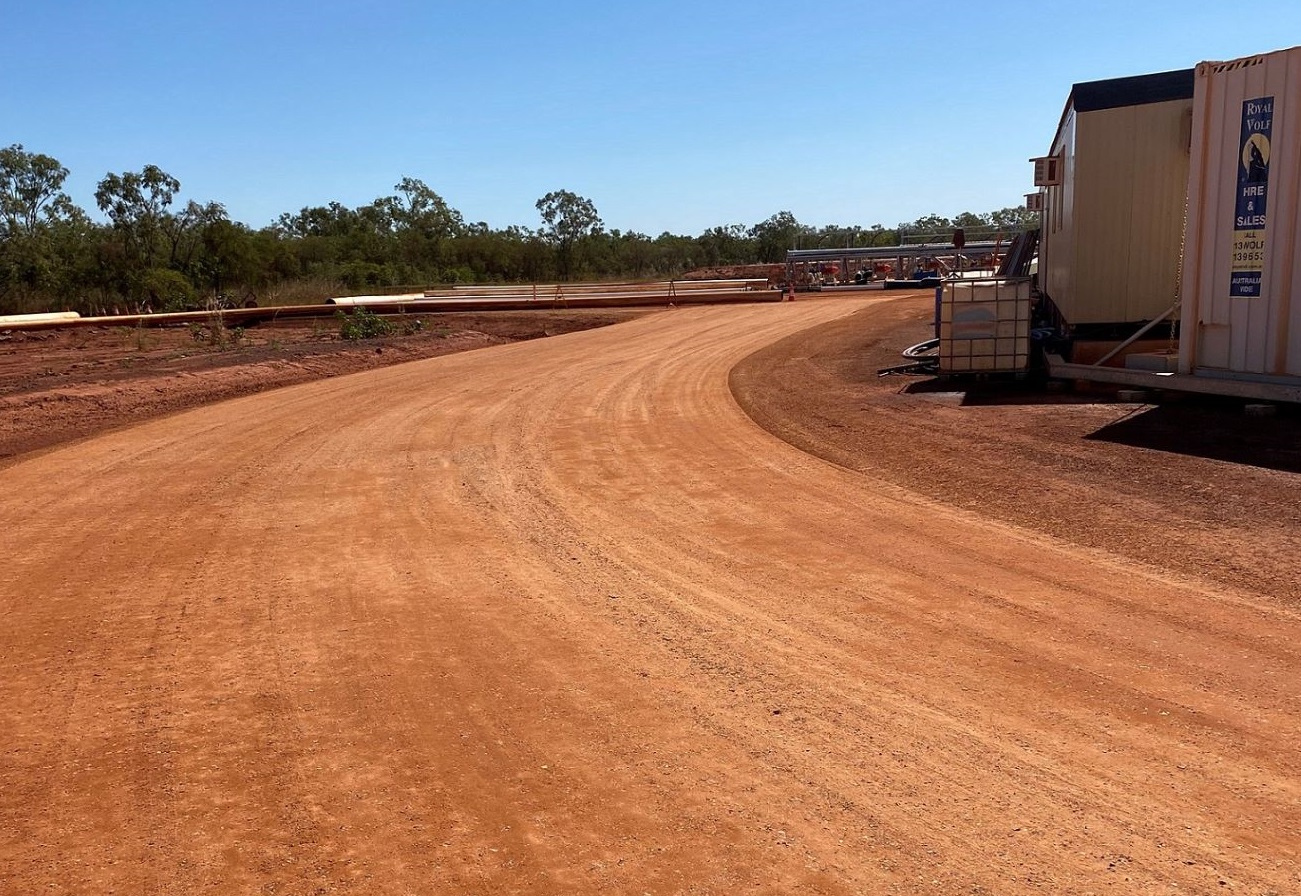
Lee Gailer, RST, Australia looks at how the company is solving the unique issues arising from new methods and technologies in the mining industry.
Finding ways to significantly minimise dust while remaining compliant with environmental restrictions, as well as maintaining maximum production levels, is a juggling act for many mine site operators.
The task of ensuring all obligations and expectations are met to protect both the health of mine workers and the environment is an ongoing challenge. However, it is a challenge that differs greatly from site to site depending on local regulations and various conditions, including the weather and types of materials being handled.
There is no ‘one size fits all’ approach to dust suppression – after three decades of research and development, fine particle specialist Reynolds Soil Technologies (RST) is still adapting its products to suit specific types of materials being handled and solve unique issues that arise from new methods and technologies.
However, the company’s products and solutions aim to deliver the qualities important to mine operators (cost-effective, efficient, safe, etc.) and also take into consideration the material being used or handled onsite, allowing for customisation to help reach maximum potential.
Health and the environment
RST works with companies that deal with airborne contaminants to reduce their environmental and health impacts caused by all types of fugitive dust emissions generated across mining operations and their material supply chain, with particular focus on reducing the amount of water being used.
The global environmental specialist company develops and supplies mechanical equipment, engineering services and total-managed systems for dust suppression, road and soil stabilisation water and sediment solutions and erosion control.
Increasing awareness of the many health and environmental issues caused by dust is resulting in more local authorities requiring mine operators to demonstrate that all reasonably-practicable hazard controls are in place and that every attempt is being made to significantly reduce dust.
The company’s dust control solutions assist mining companies in meeting the legal requirements for managing airborne contaminants with mininal processes.
Dust control in Australia
The company is based in Australia, which has some of the highest health and safety standards in the world, setting the benchmark for the company’s range of advanced products and services that promote higher levels of understanding about dust control.
Mines in Australia are using the company’s dust binding and foaming agents to assist with compliance to new legislation for occupational dust that halves the exposure limits for silica dust to 0.05 mg/m3 and reduces the limit for other mineral dust to 1.5 mg/m3 from 2.5 mg/m3, a further reduction from the original 3.5 mg/m3, to further protect worker’s health.
David Handel, Operations and Technical Director at RST, said demand for advanced dust control solutions had increased considerably, with mining companies seeking effective methods to address hazardous coal and silica dust.
He said there has been an increasing demand from mining companies for RST’s Hi-Foam product as they seek ways to cope with water restrictions and keep operations running as normal: “Our Hi-Foam dust suppression foaming system has proven to be highly beneficial to mining, quarrying and civil construction companies with minimal access to water.”
“The system requires minimum moisture to create an abundant robust foam for a total blanket effect that suppresses dust from the movement of material through crushers, transfer points and conveyor systems.
“The Hi-Foam system is an effective solution for conveying and crushing operations in underground coal mining operations where moisture limitations on materials is critical, because the system treats large areas with a significantly small amount of water to keep the air clean for workers.”
A commitment to dust control
Handel also commented on the company’s higher level of inquiry for dust control solutions that it was receiving as more mining companies demonstrated a genuine commitment to dust control, by including monitoring and control methods in their environmental management and project management plans.
He said the company’s assistance in implementing regular monitoring, reducing over-reliance on water and introducing innovative dust control techniques was significantly improving the impact of mining operations on the environment and occupational health.
This is especially relevant as mining operators are concerned with these issues: “Mining operators are calling for solutions that deliver a range of benefits; products that save water, time and money, are accessible, easy to use and able to be adapted across a range of applications, from construction and maintenance of haul roads to suppressing dust on material being transferred or stockpiled.”
Guardian Road Binder, which has generated sales of up to 300 T in the past 18 months since it was introduced to various markets, and Guardian Dust Binder are being used to build and maintain unpaved roads to significantly minimise dust and improve the road condition for longer periods of time.
The quality of roads constructed using the Guardian products has proven to be suitable for haul roads supporting autonomous vehicles on 24-hour haulage cycles.
Handel also mentioned that the company’s Research and Development Programme has been observing autonomous trials at mine sites for many years to understand how automated mining programmes operate in order to support the development of new technology in addressing the associated issues.
“When new technologies and methods are introduced to our clients’ industries, our research and development team looks at the new challenges they present in terms of dust and other fine particle issues,” he explained.
“What we found immediately interesting in the early days of the trials was that the truck’s autonomous system perceived dust as a wall so it would stop and shut down the truck when it drove into dust from the vehicle in front.
“We identified the need for new dust control technology aimed at controlling dust on haul roads coping with extremely high volumes of heavy vehicle traffic to enable driverless haul trucks to operate at full capacity for 24 hours a day.
“Autonomous mining operators need to have minimal interaction between autonomous vehicles and manned auxiliary equipment used to mitigate dust and maintain the running surface, so we focused on developing and modifying road stabilisers and dust binders that control the dust and maintain optimal running surfaces for significantly longer periods of time.
“This reduced the need for intense and regular maintenance, with reduced surface spraying required and this significantly removed the need for interaction between driverless trucks and manned auxiliary equipment.”
Technology and dust control
Technological advances have also dramatically increased workers to dust exposure. High-pressure power and air equipment used in mining, sandblasting and other industrial settings create fine minute dust particles that require highly effective dust control techniques to protect workers.
This ever-evolving issue of occupational dust exposure is managed and addressed by the company’s advanced technologies designed to be versatile, cost effective and offer both short and long-term mitigation results.
“Through our extensive research over the last 30 years, we’ve developed ground-breaking technology to mitigate the many complicated issues dust can cause across an entire mining operation,” Handel continued.
“Companies are committed to ensure that operations do not impact on workers’ health, and maintaining clean air is now considered a priority in most parts of the world.
“Our environmentally-safe solutions assist in establishing clear standards for mining companies to balance progress with health-related priorities and environmental protection.
“Mining companies are mindful about water consumption and we have been seeing significant demand for our products that require less water, especially from companies in parts of the world dealing with drought and water shortages.
“We’ve been recording substantial increases in the supply of our water-saving solutions every year for the past five years as mining companies continue to look for ways to improve efficiencies and reduce water consumption to lessen the environmental impacts of their operations.”
While the company’s range of foaming and polymeric dust suppressants are widely used to suppress dust, a major benefit is their ability to further assist with the prevention of dust, helping change the general perception of dust pollution as a condition that needs monitoring and control to a situation that can potentially be prevented.
“The way in which a product is applied to a site can impact performance considerably, which is why we customise both the product and the application equipment to achieve maximum benefits,” Handel said.
“When we develop a new product or system, our aim is to achieve immediate results, dramatically cut down water usage, improve safety outcomes and most importantly, address the needs of our clients.
“Mining sites and quarries within Australia and across the world are having to be a lot more mindful about their water consumption as increased pressure is being placed on them to ensure their operations have less of an environmental impact.
“As such, we are supplying large amounts of our Hi-Foam product to projects in Australia where water is scarce, as well as copper and gold mines in Chile, which are experiencing the driest decade in recorded history with the drought not showing any signs of ending soon.”
Conclusion
The Guardian and Hi-Foam formulas are just an example of the many innovative products developed by the company to assist other companies in the mining and quarrying, civil construction and agriculture industries around the world.
New solutions for dust, erosion and other fine particle issues caused by new technologies and traditional mining processes are currently being explored by its Research and Development Programme.



